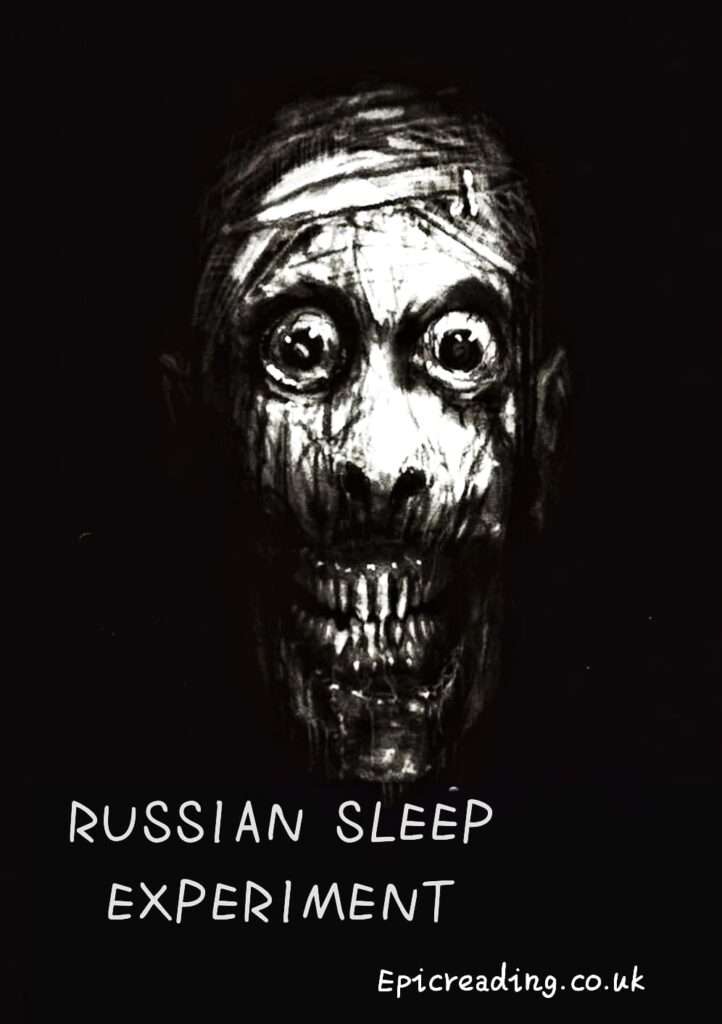
The Experiment That Should Never Have Happened
In the frozen depths of post-war Soviet Russia, where science and secrecy walked hand in hand, a classified experiment was conducted—one so horrific that even the most hardened researchers vowed never to speak of it again.
The goal? To create the perfect soldier.
The method? Sleep deprivation.
What began as a controlled study quickly spiraled into an unspeakable nightmare—a tale of madness, self-mutilation, and a final revelation so horrifying that it would shake the foundations of what it means to be human.
But was it just an internet legend? Or did the Soviet Union hide something far more terrifying?
The Origins of the Russian Sleep Experiment
The story first appeared on Creepypasta forums in 2010, detailing an alleged Soviet military experiment from the 1940s. The premise was simple yet disturbing:
- Five political prisoners were chosen as test subjects.
- They were sealed inside an airtight chamber and exposed to an experimental gas designed to eliminate the need for sleep.
- Scientists monitored them through one-way mirrors, microphones, and oxygen sensors.
- The goal: Keep them awake for 30 days to study the effects of extreme sleep deprivation.
At first, the experiment seemed to work. The prisoners remained lively and cooperative, engaging in quiet conversations and reading material provided by the researchers. But as days passed, their behavior started to change in ways no one could have anticipated.

The Descent Into Madness: The First Signs of Horror
By Day 5, the prisoners stopped talking to each other.
By Day 7, they began whispering to themselves, displaying paranoia and erratic behavior.
- They talked to unseen figures in the darkness.
- They screamed for hours until their voices became raw.
- They tore pages from books and pasted them over the mirrors, preventing the researchers from seeing inside.
But what was most unsettling? The chamber was silent.
The prisoners had stopped reacting to outside attempts at communication. The only sound was the constant, unnerving hum of the air vents pumping in the gas.
And then, on Day 15, came the moment that turned this from an experiment into a waking nightmare.
When the researchers finally decided to check inside the chamber, they turned off the gas and announced via intercom that the experiment was over.
What they heard next chilled them to their core.
A single voice whispered through the microphone:
“We no longer want to be freed.”
When the researchers opened the chamber, they were met with a sight beyond comprehension.
- The floor was covered in blood, but there were no visible wounds on most of the subjects.
- Large chunks of skin and flesh were missing, not from attacks—but from self-inflicted mutilation.
- One subject had gouged out his own eyes and stuffed them into his mouth.
- Another had ripped open his own abdomen, pulling out his intestines, yet continued to move as if he felt no pain.
- The chamber’s drains were clogged with a thick, reddish-brown sludge—a mixture of blood, water, and excrement.
The most terrifying part?
They were still alive.
Despite their grotesque injuries, the test subjects refused to leave the chamber. They begged—screamed—for the gas to be turned back on.
They attacked the researchers, showing inhuman strength, even as their bodies were on the verge of collapse.
One scientist was killed when a subject ripped out his throat with his bare teeth.
Another was torn apart by two of the remaining test subjects, his body reduced to a pile of shredded flesh.
The remaining soldiers were so horrified that they refused to enter the chamber, opting instead to shoot the prisoners.
But even after being shot multiple times, one of them continued speaking…
As the last surviving test subject lay dying on the operating table, one of the horrified researchers asked:
“What are you?”
The prisoner grinned—a wide, unnatural smile stretching across his mutilated face.
Then, in a guttural, rasping whisper, he spoke his final words:
“Have you forgotten so easily? We are you. We are the madness that lurks within all of you, begging to be free at every moment in your deepest mind. We are what you hide from in your beds every night. We are what you sedate into silence and paralysis when you go to the nocturnal haven where we cannot tread.”
Then… he flatlined.
The experiment was buried in secrecy. All involved were either executed or disappeared. The facility was abandoned.
The Soviet Union never spoke of the experiment again.
But the real horror?
What if the experiment never truly ended?
While the Russian Sleep Experiment is widely regarded as fiction, it draws inspiration from real-world sleep deprivation studies that have shown disturbing effects on the human brain.
- The MKUltra Project (1950s-1970s) saw the U.S. government experiment with mind control and psychological manipulation.
- The Soviet Union conducted brutal biological experiments during Stalin’s reign, many of which remain classified.
- Sleep deprivation studies have shown severe psychosis can begin in as little as 72 hours without sleep.
So, while there is no official record of this experiment, its core horror—what happens when the mind is pushed past its limits—remains terrifyingly real.
The Russian Sleep Experiment taps into deep psychological fears that make it feel real:
- Fear of losing control: The idea that we could turn into something monstrous without realizing it.
- Fear of the unknown: Did something inhuman awaken in those prisoners?
- Fear of government secrets: What other horrific experiments have been buried in history?
Even though it’s a creepypasta, it continues to terrify because we know…
Somewhere, behind locked doors in hidden laboratories… scientists are still pushing human limits.
And the question remains: What happens when we finally break?
Whether fact or fiction, the Russian Sleep Experiment is a story that refuses to fade—because it speaks to something primal within us all.
Tonight, when you close your eyes, remember:
Sleep isn’t just rest. It’s protection.
Because without it… you might awaken something you can’t control.





